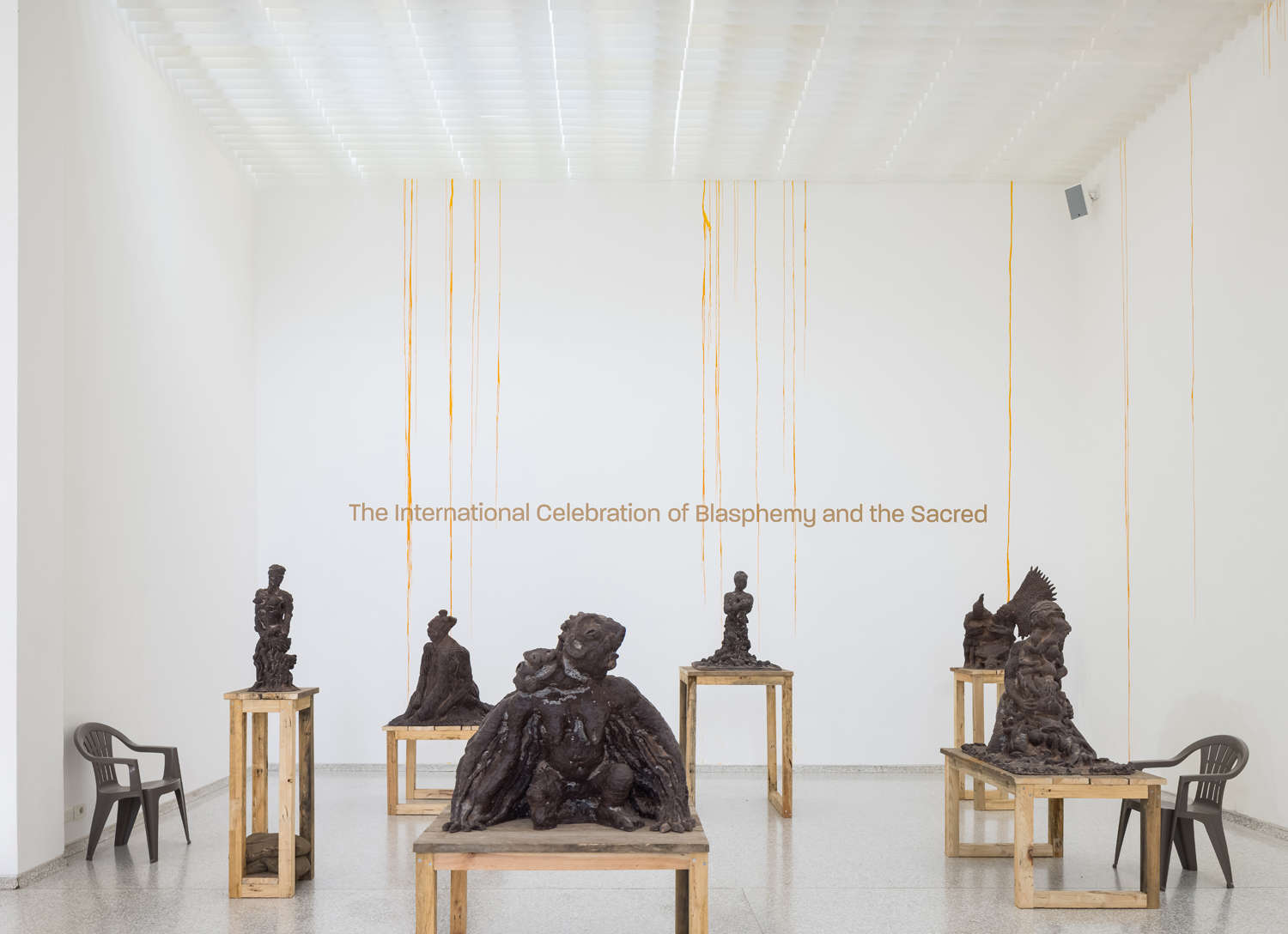For the 60th International Art Exhibition - La Biennale di Venezia, the Congolese artist collective Cercle d’Art des Travailleurs de Plantation Congolaise (CATPC) celebrates the blasphemous and the sacred within the Dutch Pavilion, displayed in the Giardini della Biennale at Sestiere Castello, Venice. Created in collaboration with artist Renzo Martens and curator Hicham Khalidi, the work highlights CATPC’s effort to reclaim depleted plantation lands and restore the Sacred Forest, along with their broader mission of spiritual, ethical and economic revision. The sculptures on display in the Pavilion are made of clay from the remaining old-growth forests around Lusanga and reworked with cocoa and palm oil in Amsterdam. Using these raw materials in fact, the CATPC group displays their ideas in the same fruits produced on the plantation, arguing that these plantations are still being exploited today and the extracted wealth continues to flow into museums through corporate sponsorships. The goal of the exhibition is thus to write a scenario in which good contaminates evil and in which problems become solutions.
CATPC, located in Lusanga in the Democratic Republic of Congo, has been able to acquire plots of exhausted palm oil plantations once confiscated by Unilever and its subsidiaries, where they now live and work. In ten years, the collective has reclaimed 200 hectares of confiscated land, promoting harmonious coexistence between humans and nature, an endeavor called “postplanning” to regenerate the land and develop a sustainable economy. In their Pavilion, they exhibited works that symbolize the transition from a painful past to a sustainable future, where the Sacred Forest will take center stage. They criticize museums and galleries as vehicles of dominant ideologies, seeking to reverse this view with their exhibition space in Lusanga, the Lusanga White Cube, which they consider representative of all white cube institutions in the world. In 2023, through the film-performance "The Judgement of the White Cube,“ CATPC condemned the very concept of the White Cube, calling for its resources to be committed for the sake of post-planting. The artists in the collective therefore hope that their story can inspire global changes starting with the Dutch Pavilion, another example of the ”white cube," designed by Gerrit Rietveld in 1954. The twinning between the Lusanga White Cube and the Dutch Pavilion creates a unique communication channel: thanks to a live video feed between the two spaces, the audience in Lusanga can interact with the audience in the Dutch Pavilion. It is therefore an innovative way to break down geographic barriers and allow a direct dialogue between two distant realities, creating a cultural and human bridge between two worlds. During the Art Biennale, the White Cube in Lusanga became a sanctuary for the Balot power figure sculpture created by artist Kwilu Pende. The sculpture depicts Belgian colonial officer Maximilien Balot, who was responsible for the forced recruitment of workers on behalf of Unilever until they rebelled and he was killed in 1931. The sculpture was carved as an act of resistance, to harness Balot’s rebellious spirit on behalf of the Pende people.
“We are not sure whether good intentions have the desired result or whether good intentions really lead to a Sacred Forest. In fact, we are only at the beginning. And even if it works, it’s a small step on the road to regenerating those forests (in the four corners of Congo),” says CATPC representative Ced’art Tamasala.

CATPC’s recent exhibitions include: The Learning Garden, After Rain, Diriyah Contemporary Art Biennale, Saudi Arabia/online (2024); In Schitterend Licht, Wereldmuseum, Leiden, Netherlands (2023); Fruits of Labor, Museum Dhont-Dhaenens, Deurle, Belgium (2023); Kunsthal Charlottenborg Biennale 2023, Copenhagen, Denmark (2023); Someone is Getting Rich, Tropenmuseum, Amsterdam, The Netherlands (2023); Dig Where You Stand, Palais de Lomé, Togo (2023); Economics the Blockbuster - It’s not Business as Usual, The Whitworth Manchester, United Kingdom (2023); Memoryis an Editing Station, 22nd Sesc_Videobrasil Biennale, São Paulo, Brazil (2023); The Way We Are 4. 0, Weserburg Museum of Modern Art, Bremen, Germany (2023); Monomaterial, Kunstsaele, Berlin, Germany (2023); Remember Me: Liberated Bodies, Charged Objects, Lagos Photo Festival, Lagos, Nigeria (2022); Toxicity, Lubumbashi Biennale VII, Lubumbashi, DRC (2022); Dig Where You Stand, SCCA Tamale, Ghana (2022); Hurting and Healing: Let’s Imagine a Different Heritage, Tensta konsthall, Stockholm, Sweden (2022); Time is Going - Archive and Future Memories, Dak’art Biennale off-program, EUNIC Sénégal, Dakar, Senegal (2022); taple: What’s on your plate?, Hayy Jameel, Jeddah, Saudi Arabia (2021); BALOT, KOW Berlin, Germany (2022).
 |
| Biennale, at the Dutch Pavilion works by Congolese collective CATPC made with cocoa and palm oil |
Warning: the translation into English of the original Italian article was created using automatic tools. We undertake to review all articles, but we do not guarantee the total absence of inaccuracies in the translation due to the program. You can find the original by clicking on the ITA button. If you find any mistake,please contact us.